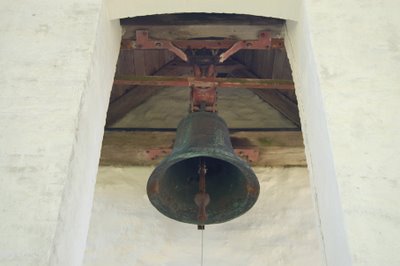Church Bells
Church bells became common in Europe in the early Middle Ages. They were first common in northern Europe, reflecting Celtic influence, especially that of Irish missionaries. Before the use of church bells, Greek monasteries would ring a flat metal plate to announce services. The signa and companae used to announce services before Irish influence may have been flat plates like the semantron rather than bells. The oldest surviving circle of bells in the world is housed in St. Lawrence Church, Ipswich.
In World War II in Great Britain, all church bells were silenced, to ring only to inform of an invasion by enemy troops. The episode "The Battle of Godfrey's Cottage" of the BBC sitcom Dad's Army included a scene where the church bells rang by mistake, leading the Home Guard to believe that an invasion was taking place.
The process of casting bells is called bellmaking or bellfounding, and in Europe dates to the 4th or 5th century. The traditional metal for these bells is a bronze of about 23% tin. Known as bell metal, this alloy is also the traditional alloy for the finest Turkish and Chinese cymbals. Other materials sometimes used for large bells include brass and iron.
Bells are also associated with clocks, indicating the hour by ringing. Indeed, the word clock comes from the Latin word cloc meaning bell. Clock towers or bell towers can be heard over long distances which was especially important in the time when clocks were too expensive for widespread use. In many languages the same word can mean both "clock" and "bell". In the case of clock towers and grandfather clocks a particular sequence of tones may be played to represent the hour. One common pattern is called the "Westminster Quarters", a sixteen-note pattern named after the Palace of Westminster which popularized it as the measure used by Big Ben.
Ræhr church, North Jutland
Some church bells are electronically timed to chime automatically. Clocks generally automatically strike, but in the United Kingdom, bells for services, etc., are still almost always rung by people. Some churches use recorded or digitally synthesized bells. In the Eastern Orthodox Church there is a long and complex history of bell ringing, with particular bells being rung in particular ways to signify different parts of the divine services, Funeral tolls, etc. This custom is particularly sophisticated in the Russian Orthodox Church. Russian bells are usually fixed, and are tolled by pulling on a rope that is attached to the clapper so that it will strike the side of the bell.
In the Western world its most classical form is a church bell or town bell, which is hung within a tower and sounded by having the entire bell swung by ropes, whereupon an internal hinged clapper strikes the body of the bell. A set of bells, hung in a circle for change ringing is known as a ring of bells. In the Eastern world, the traditional forms of bells are temple and palace bells, small ones being rung by a sharp rap with a stick, and very large ones rung by a blow from the outside by a large swinging beam.
Tæbring church , Mors, North Jutland, outside bell tower.
Famous Bells
The Great Bell of Dhammazedi (1484) may have been the largest bell ever made. It was lost in a river in Myanmar after being removed from a temple by the Portuguese in 1608. It is reported to have been about 300 tonnes in weight. The Tsar bell by the Morotorin Bellfounders is the largest bell still in existence. It weighs 160 tonnes, but it was never rung and broke in 1737. It is on display in Moscow, Russia, inside the Kremlin. The Great Mingun bell is the largest functioning bell. It is located in Mingun, Myanmar and weighs 90 tonnes.
Pummerin in Vienna's Stephansdom is the most famous bell in Austria and the fifth largest in the world. The South West tower of St. Paul's Cathedral in London, England houses Great Paul, the largest bell (16,5 tons) in the British Isles. One can hear Great Paul booming out over Ludgate Hille at 1300 every day. Big Ben is the third largest bell in the British Isles. It is the hour bell of the Great Clock in the Clock Tower at the Palace of Westminster, the home of the Houses of Parliament in the United Kingdom.
The Liberty bell is an American bell of great historic signifance, located in Philadelphia, Pennsylvania. It previous hung in Independence Hall and was rung on July 4, 1776 to mark American Independence. Little John, named after the character from the legends of Robin Hood is the bell within the clock tower of Nottingham Council House. It was the deepest toned clock bell in the United Kingdom until Great Peter of York Minster was incorporated into a new clock chime to celebrate the Queen Mother's centenary. Great Peter is deeper than Little John by only a few Hz. The sound of Little John is said to be heard over the greatest distance of any bell in the UK, occassionally on quiet days being heard in Derby.
photo: gb


No comments:
Post a Comment